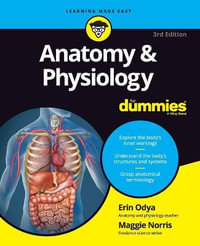
Choosing and Using Statistics
A Biologist's Guide
By: Calvin Dytham
Paperback | 10 December 2010 | Edition Number 3
At a Glance
320 Pages
Revised
24.46 x 17.17 x 1.72
Paperback
RRP $68.95
$45.50
34%OFF
or 4 interest-free payments of $11.38 with
orAims to ship in 7 to 10 business days
Industry Reviews
"Written in a concise and direct style, this book presents a selection of some of the most widely used statistical tests and data exploration techniques ... In general, this book is a very good primer for students with no statistical expertise." (Biological Conservation Reviews, 2011)
"This book makes everything so easy. Complicated tests are effortlessly condensed, and the instructions are almost too easy to follow. Diagrams and sample data sets are used frequently so you can practise using tests before applying them to your own data sets, whilst the logical layout guides you toward the correct test for both your data, and what you want to prove (or disprove)." (Animals & Men, February 2011)
The third edition xiv
How to use this book xiv
Packages used xv
Example data xv
Acknowledgements for the first edition xv
Acknowledgements for the second edition xv
Acknowledgements for the third edition xvi
1 Eight steps to successful data analysis 1
2 The basics 2
Observations 2
Hypothesis testing 2
P-values 3
Sampling 3
Experiments 4
Statistics 4
Descriptive statistics 5
Tests of difference 5
Tests of relationships 5
Tests for data investigation 6
3 Choosing a test: a key 7
Remember: eight steps to successful data analysis 7
The art of choosing a test 7
A key to assist in your choice of statistical test 8
4 Hypothesis testing, sampling and experimental design 23
Hypothesis testing 23
Acceptable errors 23
P-values 24
Sampling 25
Choice of sample unit 25
Number of sample units 26
Positioning of sample units to achieve a random sample 26
Timing of sampling 27
Experimental design 27
Control 28
Procedural controls 28
Temporal control 28
Experimental control 29
Statistical control 29
Some standard experimental designs 29
5 Statistics, variables and distributions 32
What are statistics? 32
Types of statistics 33
Descriptive statistics 33
Parametric statistics 33
Non-parametric statistics 33
What is a variable? 33
Types of variables or scales of measurement 34
Measurement variables 34
Continuous variables 34
Discrete variables 35
How accurate do I need to be? 35
Ranked variables 35
Attributes 35
Derived variables 36
Types of distribution 36
Discrete distributions 36
The Poisson distribution 36
The binomial distribution 37
The negative binomial distribution 39
The hypergeometric distribution 39
Continuous distributions 40
The rectangular distribution 40
The normal distribution 40
The standardized normal distribution 40
Convergence of a Poisson distribution to a normal distribution 41
Sampling distributions and the 'central limit theorem' 41
Describing the normal distribution further 41
Skewness 41
Kurtosis 43
Is a distribution normal? 43
Transformations 43
An example 44
The angular transformation 44
The logit transformation 45
The t-distribution 46
Confidence intervals 47
The chi-square distribution 47
The exponential distribution 47
Non-parametric 'distributions' 48
Ranking, quartiles and the interquartile range 48
Box and whisker plots 48
6 Descriptive and presentational techniques 49
General advice 49
Displaying data: summarizing a single variable 49
Box and whisker plot (box plot) 49
Displaying data: showing the distribution of a single variable 50
Bar chart: for discrete data 50
Histogram: for continuous data 51
Pie chart: for categorical data or attribute data 52
Descriptive statistics 52
Statistics of location or position 52
Arithmetic mean 53
Geometric mean 53
Harmonic mean 53
Median 53
Mode 53
Statistics of distribution, dispersion or spread 55
Range 55
Interquartile range 55
Variance 55
Standard deviation (SD) 55
Standard error (SE) 56
Confidence intervals (CI) or confidence limits 56
Coefficient of variation 56
Other summary statistics 56
Skewness 57
Kurtosis 57
Using the computer packages 57
General 57
Displaying data: summarizing two or more variables 62
Box and whisker plots (box plots) 62
Error bars and confidence intervals 63
Displaying data: comparing two variables 63
Associations 63
Scatterplots 64
Multiple scatterplots 64
Trends, predictions and time series 65
Lines 65
Fitted lines 67
Confidence intervals 67
Displaying data: comparing more than two variables 68
Associations 68
Three-dimensional scatterplots 68
Multiple trends, time series and predictions 69
Multiple fitted lines 69
Surfaces 70
7 The tests 1: tests to look at differences 72
Do frequency distributions differ? 72
Questions 72
G-test 72
An example 73
Chi-square test 75
An example 76
Kolmogorov?Smirnov test 86
An example 87
Anderson?Darling test 89
Shapiro?Wilk test 90
Graphical tests for normality 90
Do the observations from two groups differ? 92
Paired data 92
Paired t-test 92
Wilcoxon signed ranks test 96
Sign test 99
Unpaired data 103
t-test 103
One-way ANOVA 111
Mann?Whitney U 119
Do the observations from more than two groups differ? 123
Repeated measures 123
Friedman test (for repeated measures) 123
Repeated-measures ANOVA 127
Independent samples 128
One-way ANOVA 129
Post hoc testing: after one-way ANOVA 138
Kruskal?Wallis test 142
Post hoc testing: after the Kruskal?Wallis test 145
There are two independent ways of classifying the data 145
One observation for each factor combination (no replication) 146
Friedman test 146
Two-way ANOVA (without replication) 152
More than one observation for each factor combination (with
replication) 160
Interaction 160
Two-way ANOVA (with replication) 163
An example 164
Scheirer?Ray?Hare test 175
An example 175
There are more than two independent ways to classify the data 182
Multifactorial testing 182
Three-way ANOVA (without replication) 183
Three-way ANOVA (with replication) 184
An example 184
Multiway ANOVA 191
Not all classifications are independent 192
Non-independent factors 192
Nested factors 192
Random or fixed factors 193
Nested or hierarchical designs 193
Two-level nested-design ANOVA 193
An example 193
8 The tests 2: tests to look at relationships 199
Is there a correlation or association between two variables? 199
Observations assigned to categories 199
Chi-square test of association 199
An example 200
Cramer coefficient of association 208
Phi coefficient of association 209
Observations assigned a value 209
'Standard' correlation (Pearson's product-moment correlation) 210
An example 210
Spearman's rank-order correlation 214
An example 215
Kendall rank-order correlation 218
An example 218
Regression 219
An example 220
Is there a cause-and-effect relationship between two variables? 220
Questions 220
'Standard' linear regression 221
Prediction 221
Interpreting r2 222
Comparison of regression and correlation 222
Residuals 222
Confidence intervals 222
Prediction interval 223
An example 223
Kendall robust line-fit method 230
Logistic regression 230
An example 231
Model II regression 235
Polynomial, cubic and quadratic regression 235
Tests for more than two variables 236
Tests of association 236
Questions 236
Correlation 236
Partial correlation 237
Kendall partial rank-order correlation 237
Cause(s) and effect(s) 237
Questions 237
Regression 237
Analysis of covariance (ANCOVA) 238
Multiple regression 242
Stepwise regression 242
Path analysis 243
9 The tests 3: tests for data exploration 244
Types of data 244
Observation, inspection and plotting 244
Principal component analysis (PCA) and factor analysis 244
An example 245
Canonical variate analysis 251
Discriminant function analysis 251
An example 251
Multivariate analysis of variance (MANOVA) 256
An example 256
Multivariate analysis of covariance (MANCOVA) 259
Cluster analysis 259
DECORANA and TWINSPAN 263
Symbols and letters used in statistics 264
Greek letters 264
Symbols 264
Upper-case letters 265
Lower-case letters 266
Glossary 267
Assumptions of the tests 282
What if the assumptions are violated? 284
Hints and tips 285
Using a computer 285
Sampling 286
Statistics 286
Displaying the data 287
A table of statistical tests 289
Index 291
ISBN: 9781405198394
ISBN-10: 1405198397
Published: 10th December 2010
Format: Paperback
Language: English
Number of Pages: 320
Audience: Professional and Scholarly
Publisher: John Wiley & Sons (UK)
Country of Publication: US
Edition Number: 3
Edition Type: Revised
Dimensions (cm): 24.46 x 17.17 x 1.72
Weight (kg): 0.71
Shipping
| Standard Shipping | Express Shipping | |
|---|---|---|
| Metro postcodes: | $9.99 | $14.95 |
| Regional postcodes: | $9.99 | $14.95 |
| Rural postcodes: | $9.99 | $14.95 |
How to return your order
At Booktopia, we offer hassle-free returns in accordance with our returns policy. If you wish to return an item, please get in touch with Booktopia Customer Care.
Additional postage charges may be applicable.
Defective items
If there is a problem with any of the items received for your order then the Booktopia Customer Care team is ready to assist you.
For more info please visit our Help Centre.
You Can Find This Book In
This product is categorised by
- Non-FictionScienceBiology, Life Sciences
- Non-FictionMathematicsProbability & Statistics
- Non-FictionMathematicsApplied Mathematics
- Text BooksHigher Education & Vocational TextbooksBiology and Sciences Higher Education Textbooks
- Text BooksTextbook FinderAustralian Catholic UniversityBMSC100 Introductory Biostatistics
























